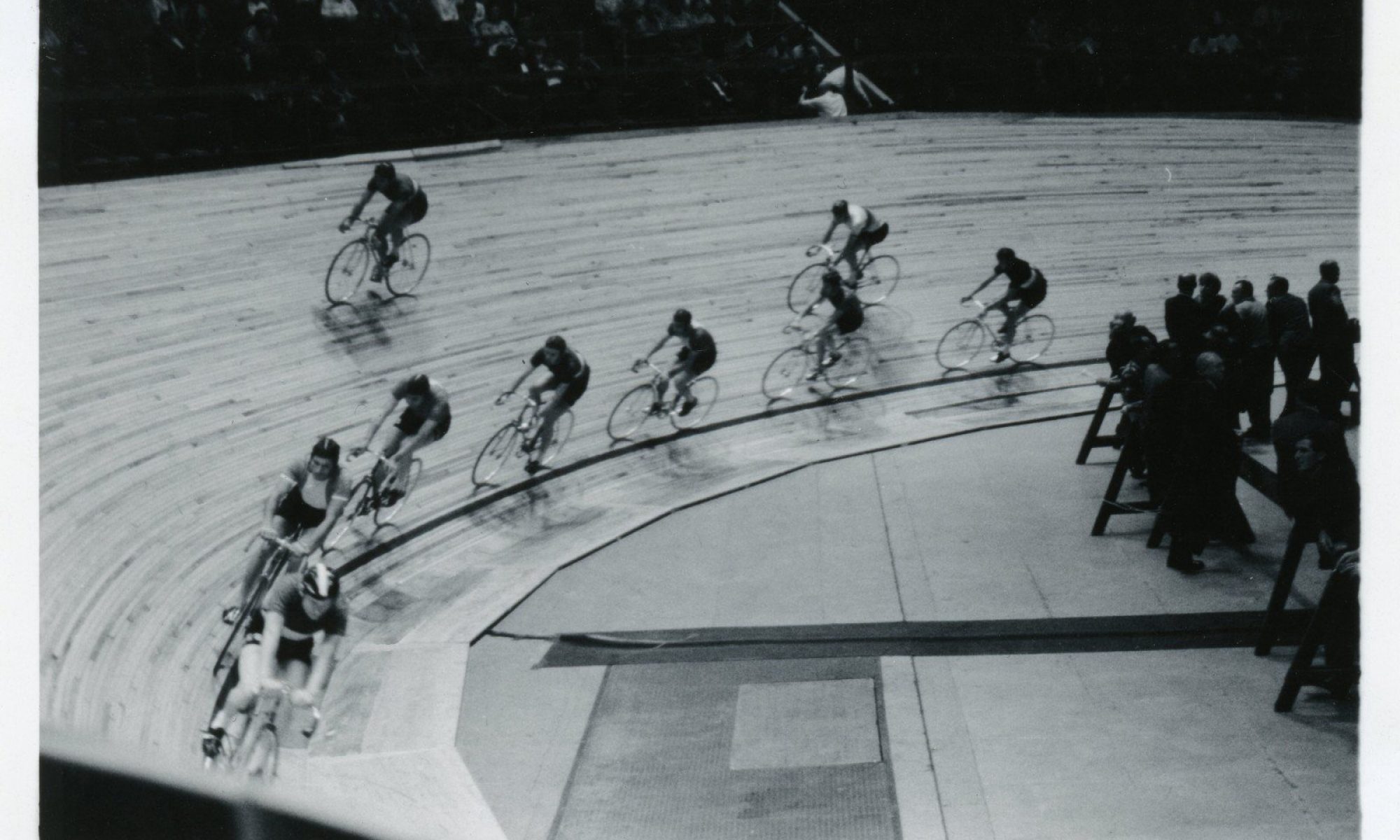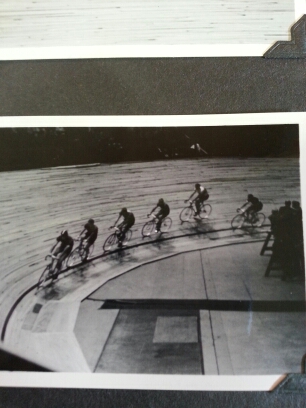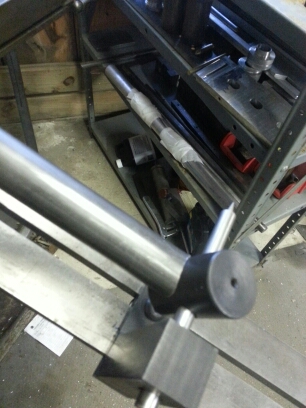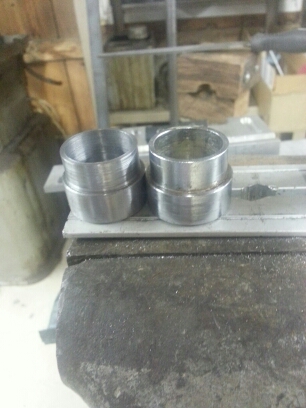Initial setup in jig. Got some more hours of cleanup and adjusting to do before brazing starts but happy with it so far.
Faux Head Set in Bronze
6 Day Race Photos
Tube Notching
Weather Station Code
Current code (needs some clean up but working) for the weather station that post to both Xively and ThingSpeak.
ThingSpeak Weather Channel
Xively Weather Station
[pre lang=”C” wrapline=”false”]
// Includes
#include <Dhcp.h>
#include <Dns.h>
#include <Ethernet.h>
#include <EthernetClient.h>
#include <EthernetServer.h>
#include <EthernetUdp.h>
#include <ThingSpeak.h>
#include <Xively.h>
#include <Wire.h>
#include <Adafruit_Sensor.h>
#include <Adafruit_TSL2561_U.h>
#include <Adafruit_BMP085_U.h>
// Setup TSL2561 and BMP085 Sensors
Adafruit_TSL2561_Unified tsl = Adafruit_TSL2561_Unified(TSL2561_ADDR_FLOAT, 12345);
Adafruit_BMP085_Unified bmp = Adafruit_BMP085_Unified(10085);
// MAC address for your Ethernet shield
byte mac[] = { 0xDE, 0xAA, 0xBB, 0xCC, 0xDE, 0x02 };
//Uploading Data to two different services for comparisons
// Your Xively key to let you upload data
char xivelyKey[] = "YOURKEYHERE";
// ThingSpeak
unsigned long myChannelNumber = 000000;
const char * myWriteAPIKey = "YOURKEYHERE";
// Define the strings for our datastream IDs for Xively
char tempID[] = "Temp";
char lightID[] = "Light";
char bpID[] = "Barometric_Pressure";
char wsID[] = "Wind_Speed";
//Setting up Windspeed
//Thanks Allison Lassiter – hackerscapes.com for help with anemometer code
int sensorPin = A0;
int sensorValue = 0;
float voltageConversionConstant = .0048828125;
float windSpeed = 0;
float sensorVoltage = 0;
float voltageMin = .4; // Mininum output voltage from anemometer in V.
float windSpeedMin = 0; // Wind speed in meters/sec corresponding to minimum voltage
float voltageMax = 2.0; // Maximum output voltage from anemometer in V.
float windSpeedMax = 32; // Wind speed in meters/sec corresponding to maximum voltage
//Data structure for Xively data upload
//Basically one for each sensor
XivelyDatastream datastreams[] = {
XivelyDatastream(tempID, strlen(tempID), DATASTREAM_FLOAT),
XivelyDatastream(lightID, strlen(lightID), DATASTREAM_FLOAT),
XivelyDatastream(bpID, strlen(bpID), DATASTREAM_FLOAT),
XivelyDatastream(wsID, strlen(wsID), DATASTREAM_FLOAT)
};
// Finally, wrap the datastreams into a feed
XivelyFeed feed(00000000, datastreams, 4 /* number of datastreams */);
//Setup Ethernet Client
EthernetClient client;
//Setup Xively client
XivelyClient xivelyclient(client);
/**************************************************************************/
/*
Displays some basic information on this sensor from the unified
sensor API sensor_t type (see Adafruit_Sensor for more information)
*/
/**************************************************************************/
void displaySensorDetails(void)
{
sensor_t sensor;
tsl.getSensor(&sensor);
Serial.println("————————————");
Serial.print ("Sensor: "); Serial.println(sensor.name);
Serial.print ("Driver Ver: "); Serial.println(sensor.version);
Serial.print ("Unique ID: "); Serial.println(sensor.sensor_id);
Serial.print ("Max Value: "); Serial.print(sensor.max_value); Serial.println(" lux");
Serial.print ("Min Value: "); Serial.print(sensor.min_value); Serial.println(" lux");
Serial.print ("Resolution: "); Serial.print(sensor.resolution); Serial.println(" lux");
Serial.println("————————————");
Serial.println("");
delay(500);
}
void displayBMPSensorDetails(void)
{
sensor_t sensor;
bmp.getSensor(&sensor);
Serial.println("————————————");
Serial.print ("Sensor: "); Serial.println(sensor.name);
Serial.print ("Driver Ver: "); Serial.println(sensor.version);
Serial.print ("Unique ID: "); Serial.println(sensor.sensor_id);
Serial.print ("Max Value: "); Serial.print(sensor.max_value); Serial.println(" hPa");
Serial.print ("Min Value: "); Serial.print(sensor.min_value); Serial.println(" hPa");
Serial.print ("Resolution: "); Serial.print(sensor.resolution); Serial.println(" hPa");
Serial.println("————————————");
Serial.println("");
delay(500);
}
/**************************************************************************/
/*
Configures the gain and integration time for the TSL2561
*/
/**************************************************************************/
void configureSensor(void)
{
/* You can also manually set the gain or enable auto-gain support */
// tsl.setGain(TSL2561_GAIN_1X); /* No gain … use in bright light to avoid sensor saturation */
// tsl.setGain(TSL2561_GAIN_16X); /* 16x gain … use in low light to boost sensitivity */
tsl.enableAutoRange(true); /* Auto-gain … switches automatically between 1x and 16x */
/* Changing the integration time gives you better sensor resolution (402ms = 16-bit data) */
tsl.setIntegrationTime(TSL2561_INTEGRATIONTIME_13MS); /* fast but low resolution */
// tsl.setIntegrationTime(TSL2561_INTEGRATIONTIME_101MS); /* medium resolution and speed */
// tsl.setIntegrationTime(TSL2561_INTEGRATIONTIME_402MS); /* 16-bit data but slowest conversions */
/* Update these values depending on what you’ve set above! */
Serial.println("————————————");
Serial.print ("Gain: "); Serial.println("Auto");
Serial.print ("Timing: "); Serial.println("13 ms");
Serial.println("————————————");
}
/**************************************************************************/
/*
Arduino setup function (automatically called at startup)
*/
/**************************************************************************/
void setup(void)
{
Serial.begin(9600);
Serial.println("Light Sensor Test"); Serial.println("");
// Setup Ethernet
while (Ethernet.begin(mac) != 1)
{
Serial.println("Error getting IP address via DHCP, trying again…");
delay(5000);
}
// print your local IP address:
Serial.print("My IP address: ");
for (byte thisByte = 0; thisByte < 4; thisByte++) {
// print the value of each byte of the IP address:
Serial.print(Ethernet.localIP()[thisByte], DEC);
Serial.print(".");
}
/* Initialise the BMP sensor */
if(!bmp.begin())
{
/* There was a problem detecting the BMP085 … check your connections */
Serial.print("Ooops, no BMP085 detected … Check your wiring or I2C ADDR!");
while(1);
}
/* Display some basic information on this sensor */
Serial.println("Found BMP");
displayBMPSensorDetails();
/* Initialise the TSL sensor */
if(!tsl.begin())
{
/* There was a problem detecting the ADXL345 … check your connections */
Serial.print("Ooops, no TSL2561 detected … Check your wiring or I2C ADDR!");
while(1);
}
/* Display some basic information on this sensor */
displaySensorDetails();
/* Setup the sensor gain and integration time */
//configureSensor();
//Setup Thingspeak client
ThingSpeak.begin(client);
/* We’re ready to go! */
Serial.println("");
}
/**************************************************************************/
/*
Arduino loop function, called once ‘setup’ is complete (your own code
should go here)
*/
/**************************************************************************/
void loop(void)
{
/* Get a new sensor event */
sensors_event_t event;
sensors_event_t tslevent;
tsl.getEvent(&tslevent);
bmp.getEvent(&event);
/* Display the results (light is measured in lux) */
if (tslevent.light)
{
Serial.print(tslevent.light); Serial.println(" lux");
//Add Light reading to Xively datastream and ThingSpeak
datastreams[1].setFloat(tslevent.light);
ThingSpeak.setField(3,tslevent.light);
}
else
{
/* If event.light = 0 lux the sensor is probably saturated
and no reliable data could be generated! */
Serial.println("Sensor overload");
}
/* Display the results (barometric pressure is measure in hPa) */
if (event.pressure)
{
/* Display atmospheric pressue in hPa */
Serial.print("Pressure: ");
Serial.print(event.pressure);
Serial.println(" hPa");
/Add Event Pressure to Xively datastream and ThingSpeak
datastreams[2].setFloat(event.pressure);
ThingSpeak.setField(1,event.pressure);
/* Calculating altitude with reasonable accuracy requires pressure *
* sea level pressure for your position at the moment the data is *
* converted, as well as the ambient temperature in degress *
* celcius. If you don’t have these values, a ‘generic’ value of *
* 1013.25 hPa can be used (defined as SENSORS_PRESSURE_SEALEVELHPA *
* in sensors.h), but this isn’t ideal and will give variable *
* results from one day to the next. *
* *
* You can usually find the current SLP value by looking at weather *
* websites or from environmental information centers near any major *
* airport. *
* *
* For example, for Paris, France you can check the current mean *
* pressure and sea level at: http://bit.ly/16Au8ol */
/* First we get the current temperature from the BMP085 */
float temperature;
bmp.getTemperature(&temperature);
datastreams[0].setFloat(temperature);
ThingSpeak.setField(2,temperature);
Serial.print("Temperature: ");
Serial.print(temperature);
Serial.println(" C");
/* Then convert the atmospheric pressure, SLP and temp to altitude */
/* Update this next line with the current SLP for better results */
float seaLevelPressure = SENSORS_PRESSURE_SEALEVELHPA;
Serial.print("Altitude: ");
Serial.print(bmp.pressureToAltitude(seaLevelPressure,
event.pressure,
temperature));
Serial.println(" m");
Serial.println("");
}
else
{
Serial.println("Sensor error");
}
//Read anemometer
sensorValue = analogRead(sensorPin);
sensorVoltage = sensorValue * voltageConversionConstant; //Convert sensor value to actual voltage
Serial.print("Sensor Value: ");
Serial.println(sensorValue);
//Convert voltage value to wind speed using range of max and min voltages and wind speed for the anemometer
if (sensorVoltage <= voltageMin){
windSpeed = 0; //Check if voltage is below minimum value. If so, set wind speed to zero.
//Write to Xively and ThingSpeak
datastreams[3].setFloat(windSpeed);
ThingSpeak.setField(4,windSpeed);
}else {
//Write to Xively and ThingSpeak
windSpeed = (sensorVoltage – voltageMin)*windSpeedMax/(voltageMax – voltageMin); //For voltages above minimum value, use the linear relationship to calculate wind speed.
datastreams[3].setFloat(windSpeed);
ThingSpeak.setField(4,windSpeed);
}
//Add all streams to Xively
Serial.println("Uploading it to Xively");
Serial.println(xivelyKey);
Serial.println(feed);
int ret = xivelyclient.put(feed, xivelyKey);
Serial.print("xivelyclient.put returned ");
Serial.println(ret);
// Update Thingspeak
// Write the fields that you’ve set all at once.
ThingSpeak.writeFields(myChannelNumber, myWriteAPIKey);
//Print voltage and windspeed to serial
Serial.print("Voltage: ");
Serial.print(sensorVoltage);
Serial.print("\t");
Serial.print("Wind speed: ");
Serial.println(windSpeed);
delay(3000);
}
[/pre]
Weather Station with Anemometer
I have been chipping away at building an Arduino based Weather Station. Upgraded to a Arduino Mega as I was running out of memory on the Uno with all the libraries and sensors I was using.
Have code reading the Anemometer/BMP180/TSL2561 at this point. (more code sharing in upcoming post).
Using basic Ethernet Shield at the moment for proof of concept. Will eventually go wireless.
Also have code writing to an Xively feed at: Weather Station
Will more than likely play with other sites like Thingspeak and or more Plot.ly.
Faux Headset
Dummy Headset – Aluminum
Dummy Headset
Got an interesting dummy headset from a friend of mine to duplicate. My intention is to use aluminum (his is steel) but I did start one from steel because I am still waiting for aluminum to show up.
The dummy headset will allow elegant and simple display of frameset. No more zip ties or ugly rubber grommets. May also aid in frame construction and prep. Will mock standard stack heights.
More pics soon as I complete the set screw and facing.
Drilling out rough size for 1″ steerer tube. Will use boring bar to finish to size.
Lower cup completed. Original upper cup off to the right.
Original and new lower cup.

























